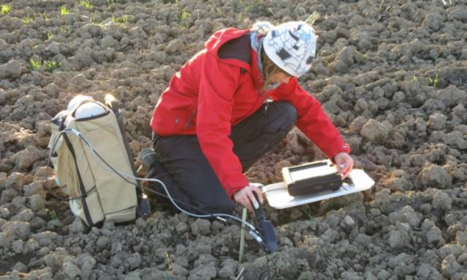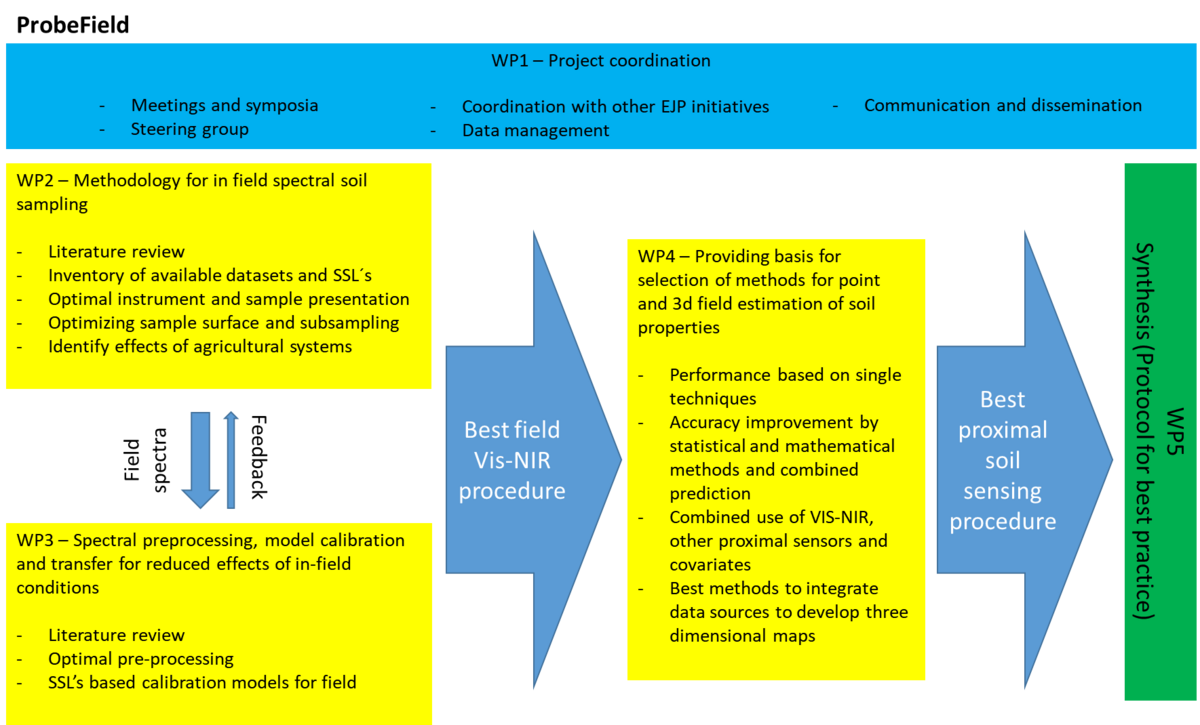ProbeField
| Start: | 1 November 2021 |
| Duration: | 36 Months |
| Aim: | ProbeField: A novel protocol for robust in field monitoring of carbon stocks and soil fertility based on proximal sensors and existing soil spectral libraries |
| Keywords: | Soil spectroscopy, vis-NIRS, proximal soil sensors, in-situ analysis, field analysis, soil fertility, soil properties, SOC stocks. |
| Contact: | Project Coordinator: Bo Stenberg (bo.stenberg@slu.se) Project communication representative: Maria Knadel (maria.knadel@agro.au.dk). |


Quick and simple soil analyses directly in the field through proximal sensing have the potential to substantially gear up the number of samples analysed. To meet the growing demand for fast and cheap analysis of soils ProbeField will focus on visible and near infrared spectroscopy (vis-NIRS) as an alternative tool to expensive and time-consuming conventional methods. The vis-NIRS technique has many advantages required for field analyses of soil properties. There are, however, drawbacks to be overcome. In contrast to lab spectroscopy, variable moisture and structure in the field will hamper reliability of analyses. ProbeField will test and suggest the most optimal physical and mathematical procedures to manage these problems. A wide range of soil properties will be analysed and 3D mapping will be performed to estimate for example carbon stocks. A best practice protocol will be produced.
The overall goal of ProbeField is to develop a set of procedures and methodologies presented in a protocol for reliable in field point estimates of fertility related properties in agricultural soils. In addition, the potential of taking data further to two and three-dimensional mapping by aid of co-variates will be illustrated. This approach will include estimations of carbon stocks, which require not only knowledge of organic matter concentrations, but also of in-situ properties like depth of the relevant horizon as well as soil density.
ProbeField is fully aligned with the focus of the DATA1 call on “Innovative techniques to monitor SOC stocks and soil degradation/restoration changes in the EU, using spectral systems/NIRS/MIRS, and other proximal sensing tools in the field”.
Scientific articles

Work packages
As most research projects ProbeField is structured in work packages (Figure 1).
- Work package 1 builds the administrative and network frame of the project and together with WP5 will be responsible for reporting and dissemination. The work packages 2 to 4 organize the actual research work. Therefore, WP2 will lay the base for the following WPs by investigating and reviewing existing literature about field soil spectroscopy and forming a data set inventory incorporating project internal and external soil spectral libraries (SSL’s) and locations with georeferenced reference data.
- WP2 will also develop or establish procedures to produce spectra as little deviating from lab spectra as possible and deliver such field spectral data sets to WP3.
- In WP3 the consortium will elaborate current knowledge on transforming field to lab spectral information and integrating co-variate information to improve quality of data transformation and soil property prediction. It will moreover investigate the possibilities of using SSL’s to estimating soil properties from field acquired spectra.
- WP4 finally will apply the acquired knowledge and experience to form 3D soil information and derive robust and interpretable products to be available to researcher, decision makers, politicians and farm practitioners alike.
- WP5 is dedicated to produce a comprehensive protocol for best practice field spectroscopy relying on lab based SSL’s.
Articles about results from ProbeField:
- Metzger, K., Liebisch, F.,Herrera, J. M., Guillaume, T., Walder, F., & Bragazza,L. 2023. The use of visible and near- infraredspectroscopy for in- situ characterization ofagricultural soil fertility: A proposition of bestpractice by comparing scanning positions andspectrometers. Soil Use and Management, 40, e12952.
- Nicolas Francos, Daniela Heller-Pearlshtien, José A. M. Demattê, Bas Van Wesemael, Robert Milewski, Sabine Chabrillat, Nikolaos Tziolas, Adrian Sanz Diaz, María Julia Yagüe Ballester, Asa Gholizadeh, Eyal Ben-Dor, "A Spectral Transfer Function to Harmonize Existing Soil Spectral Libraries Generated by Different Protocols", Applied and Environmental Soil Science, vol. 2023, Article ID 4155390, 17 pages, 2023.
- Knadel, M.; Castaldi, F.; Barbetti, R.; Ben-Dor, E.; Gholizadeh, A.; Lorenzetti, R. Mathematical techniques to remove moisture effects from visible–near-infrared–shortwave-infrared soil spectra—review , Applied Spectroscopy Reviews, 2022, DOI: 10.1080/05704928.2022.2128365
- Lopez-Nunez, R. Portable X-ray Fluorescence Analysis of Organic Amendments: A Review. Applied Sciences-Basel, 2022, 12(14).
